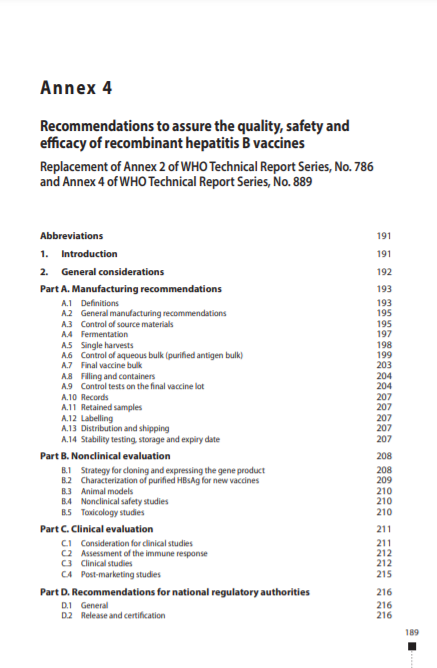Recommendations to Assure the Quality, Safety and Efficacy of Recombinant Hepatitis B Vaccines, Annex 4, TRS No 978
Replacement of Annex 2 of TRS No 786 and Annex 4 of TRS No 889

Overview
These Recommendations are intended to provide national regulatory authorities (NRAs) and vaccine manufacturers with background and guidance on the production, quality control and evaluation of the safety and efficacy of recombinant hepatitis B vaccines for prophylactic use.
The first document outlining the Requirements for the production and control of hepatitis B vaccines containing hepatitis B surface antigen (HBsAg) purified from the plasma of chronically infected individuals was adopted by the Expert Committee on Biological Standardization in 1980 and later revised in 1987. Following the development of hepatitis B vaccines containing HBsAg produced by recombinant DNA techniques in yeast, a new set of Requirements was developed subsequent to a meeting of experts in 1985 and was adopted by the Committee in 1986. These Requirements were revised to include vaccines produced by recombinant techniques in mammalian cells as well as yeast cells, in 1988.
With the development and implementation of new in vitro assays to determine antigen content, an amendment was published to include the use of the in vitro assay in the quality control of recombinant hepatitis B vaccines. The current document applies to vaccines containing HBsAg only and will replace the WHO Requirements for hepatitis B vaccine made by recombinant DNA techniques, published as Annex 2 in WHO Technical Report Series No. 786 and with a corresponding amendment in Annex 4 of WHO Technical Report Series No. 889. It should be read in conjunction with all other relevant WHO guidelines, including those on nonclinical and clinical evaluation of vaccines.
Full version of WHO Technical Report Series No.978
